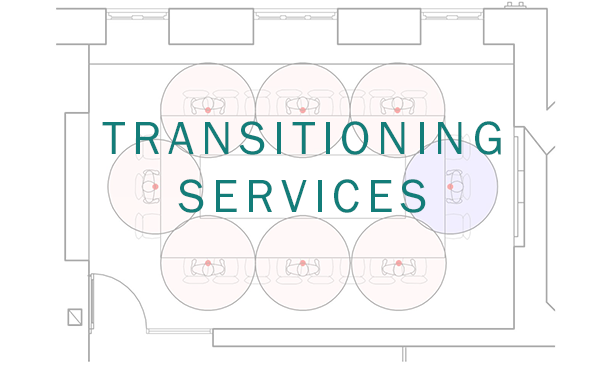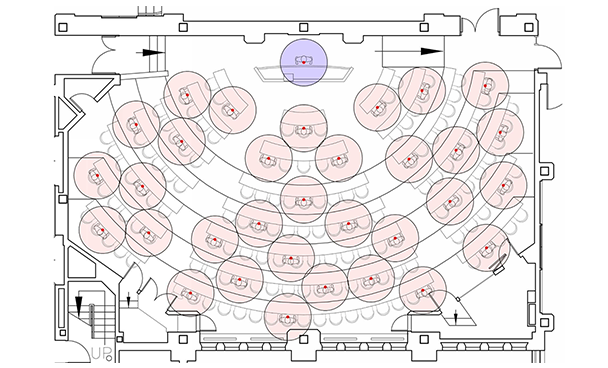Now that many schools are reopening, and parents and teachers are concerned about reducing the risk of Coronavirus transmission, we are sharing some recommendations that can be deployed quickly and inexpensively. We know that no single strategy eliminates risk, so implementing multiple risk reduction measures is the most effective way to reduce the chance of transmission and illness.
- Wear Masks
Masks are very effective at virus source control, provide protection against infection, and reduce infection severity – see this blog post for more information.
- Limit Time Spent Indoors
Transmission risk is a result of exposure concentration and duration. We know sneezing and coughing release a great number of aerosols (virus-laden particles) into the air, but breathing, speaking, and singing also release significant amounts of aerosols.[i] Physical distancing and universal masking help limit the exposure concentration, but since masks are not 100% effective at filtering aerosols, over time they can build up indoors. This is where duration becomes an issue because exposure to small amounts of virus for a continuous duration results in a higher risk of infection.
Added benefits: Time spent outdoors has been shown to have physiological, psychological, and cognitive benefits.[ii]
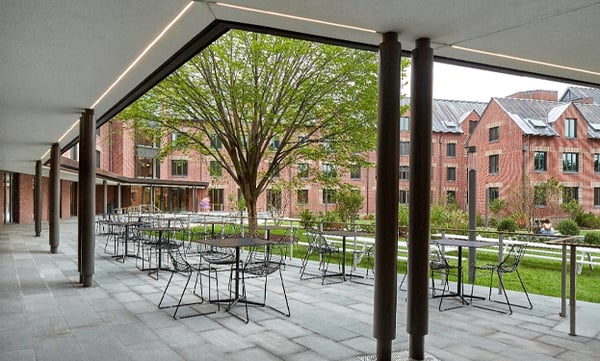
Image Source: Pirie Associates designed Yale Law School Baker Hall Courtyard, New Haven, CT
Risk of transmission outdoors is significantly lower than indoors.[iii] Outdoor teaching or even outdoor breaks offer an opportunity to reduce the risk associated with exposure duration to aerosols that have accumulated inside. If there is enough outdoor space to maintain physical distancing, then outdoor space utilization gives teachers and students the opportunity to take mask breaks as well. Outdoor breaks also allow indoor spaces to sit empty for a while, enabling the spaces to recharge by allowing aerosols to settle out of the air, be flushed, filtered, and inactivated.
- Open Doors, Windows, and Shades
The best way to replicate outdoor air levels on the interior is through an HVAC system that delivers high levels of outdoor air. However, not all building HVAC systems can do this, and it can be costly. If you don’t have the time or budget to make HVAC system modifications, you can bring outdoor air in through open doors and windows. Outdoor air effectively disperses aerosols (virus-laden particles) particles in the air,[iv] and UV from sunlight kills the virus.[v]
Added benefits: Increased levels of outdoor air also have been shown to improve cognitive function.[vi] Daylight has been shown to increase workplace productivity[vii] and regulate circadian rhythms resulting in better sleep cycles.[viii]

Image Source: Pirie Associates designed Dos Luces Brewery with a retractable storefront, Denver, CO
With doors and windows open, you can also assist the air exchange by putting a box fan at the opening that blows the interior air out. This will direct the airflow of aerosols out of the room.[ix] One caution - don’t sit close to this fan as there will be a greater concentration of aerosols in the fan’s vicinity that you are trying to remove from the room.
- Filter the Air
While the 6-ft physical distancing recommendation prevents immediate, concentrated exposure to an infected respiratory plume, aerosols have been shown to be infectious in the air beyond the 6ft distance[x], so it is important to constantly dilute and filter the air.[xi] The best way to do this is through an HVAC system that uses MERV 13 filtration. If you don’t have the time or budget to modify your HVAC system in the short-term, you can use in-room, portable solutions.
Added benefits: The good news is that filtered air has other benefits. A recent study showed that the introduction of air filtration into classrooms increased test scores.[xii]
-
- Portable Air Cleaner
HEPA Filtration air purifiers can be very effective at removing aerosols from the air.
- Portable Air Cleaner
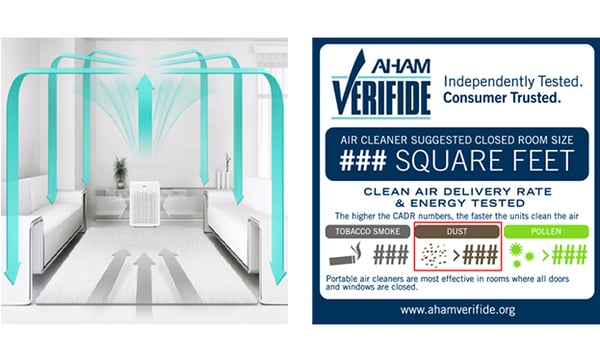 Image sources: Winix America, AHAM Certification Label
Image sources: Winix America, AHAM Certification Label-
-
- Here are some tips for selecting and placing an air cleaner:
- You can search a directory of AHAM certified air cleaners.
- The value used to evaluate air cleaners for infection risk reduction is the CADR (clean air delivery rate) for dust, which tells you the CFM (cubic feet per minute) of air that is effectively filtered of aerosols. Be aware that the CADR for dust is typically lower than the overall CADR for the cleaner.
- Target 5 ACH (air changes per hour)[xiii], or according to aerosol scientist, Shelly Miller, we should be targeting about 52.5 CFM/per person of total clean airflow.[xiv]
-
-
-
- Do not use ionization because it produces ozone, an indoor pollutant.
- The ideal place for the filter is in the middle of the room at a height where clean airflow is at the breathing zone elevation and not blowing in the vicinity of the ground surface. Avoid blowing the air across people. Ideally, clean air is blown in the upward direction.
- DIY Box Fan Filter
If you don’t have the funds or means to get a portable air cleaner (some are on backorder), there is an easy and inexpensive solution combining a box fan and furnace filter.[xv] Be aware that this will produce more noise than a standard air cleaner. We at Pirie Associates came up with our own mash-up solution by combining many of the recommendations from various DIY instructions. If you like this idea and want to give it a try, see this blog post.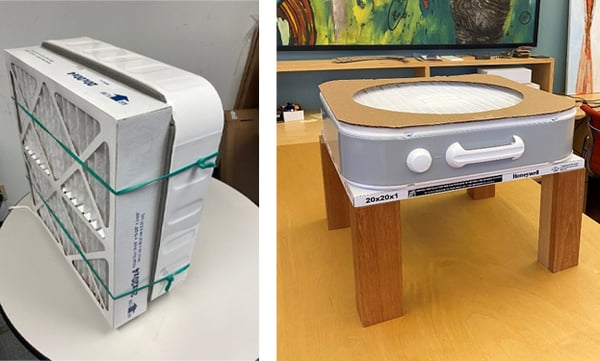
-
Image sources: Tex-Air Filters, Pirie Associates Mash-up
-
- Control Dust
It’s pretty typical for a high volume of respiratory droplets and aerosols to settle onto the floor, and virus-laden dust can be resuspended into the air by walking and vacuuming. In fact, half of the particles in the air are resuspended by walking around. A recent study showed that resuspended germy dust can be infectious.[xvi]
Added benefits: Controlling dust can limit your exposure to allergens, and toxic chemicals. [xvii]
- Control Dust
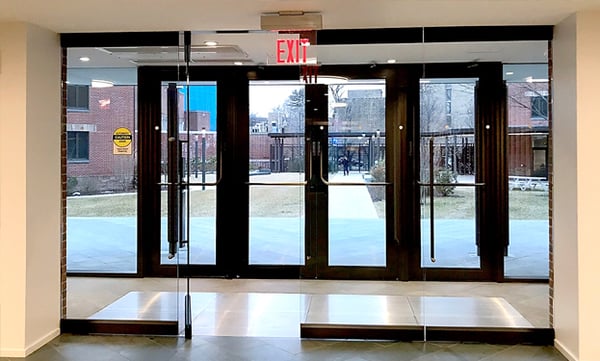 Image Source: Pirie Associates designed Yale Law School Baker Hall vestibule with built-in walk-off mat, New Haven, CT
Image Source: Pirie Associates designed Yale Law School Baker Hall vestibule with built-in walk-off mat, New Haven, CT
-
- Use Walk-off Mats
Most of the dust in a room is tracked in from outdoors on shoes – using a walk-off mat can reduce the amount of dust in a room. Clean walk-off mats frequently. - Remove Area Rugs
Carpet is more efficient at resuspending particles into the air than hard surfaces. If it is possible to remove carpet, it will reduce the amount of particles in the air.[xviii]
- Use Walk-off Mats
-
- Use Vacuums with HEPA Filtration
If carpet cannot be removed, vacuum on a frequent basis when the room is unoccupied and use a vacuum with HEPA filtration to reduce the amount of particles reintroduced to the air.
- Use Vacuums with HEPA Filtration
- Gather Air Quality Data
You can’t improve what you don’t measure. Air quality measurements are an important tool for understanding how well your air is being cleaned. You can get sensors that measure multiple metrics. The following metrics can be useful to measure in order to better understand infection risk.
Added benefit: Measuring to evaluate infection risk can also be used to evaluate general indoor air quality.
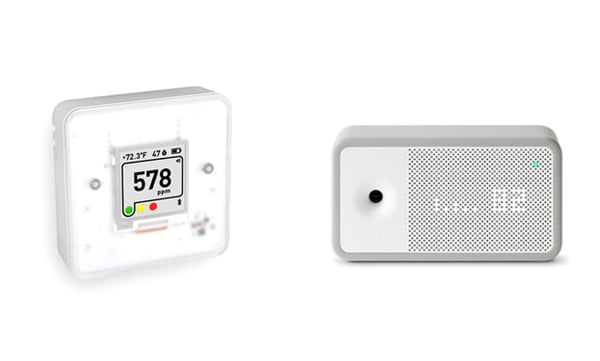 Image Source: Aranet2 Home, Awair Element
Image Source: Aranet2 Home, Awair Element
-
- CO2 Sensors
If you are relying on outdoor air to cleanse the air, knowing the level of CO2 can be an important tool in measuring how well it is working. CO2 is a good indicator of the amount of exhaled air in a space. The outdoor levels of CO2 (due to recent climate change) are about 400ppm. To mitigate infection risk inside, ideally you want to stay at 600ppm or below.[xix] One caveat for this: HEPA and MERV13 filters remove particulates, not CO2, so this measurement won’t accurately reflect infection risk, but it is best to keep CO2 less than 1000ppm in general for human health and cognition.[xx] - Particulate Sensors
These sensors are designed to measure levels of air pollution, but they can also give you a sense of how well your filtration is cleaning the air. PM 2.5, the measurement of very fine air pollution, should not exceed outdoor levels on the interior. Outdoor levels are not to exceed 35 mg/m3 for a 24-hour period and should not average more than 12 mg.m3 over the course of a year.[xxi]
- CO2 Sensors
- Don’t Lose Sight of Overall Human Health
It is important that in combating the spread of COVID-19 we do not compromise our overall health in the process.- Avoid overuse of spray disinfectants
Surface to person transmission is not thought to be the main source of virus transmission.[xxii] Many health professionals refer to the current focus on surface sanitation as “hygiene theater” meaning it is just for show. Spray cleaning and disinfection products have been associated with adverse respiratory effects in professional cleaners and among residents doing domestic cleaning[xxiii] It is important to clean surfaces and wash hands but using bleach and fogging of disinfectants, for instance, is considered overkill.[xxiv] - Avoid antimicrobials
Antimicrobials have limited benefit, if any, are associated with developmental, hormonal, and reproductive problems, and are known to cause antibiotic resistance.[xxv] Look for products with the EPA DfE (design for the environment) or Safer Choice labels.[xxvi] It is important to note that the virus cannot be absorbed through your skin, but these chemicals can. - Avoid exposure to air pollution
It is important not to confuse outdoor air with fresh air. If you are in an area close to a highway or where there is a lot of air pollution, you will want to filter the outdoor air in addition to the indoor air. Air pollution has very well documented negative health effects.[xxvii]
It is also important to understand that the increased energy use from increased ventilation rates can create more outdoor air pollution. Planning now to adapt ventilation systems to provide increased ventilation as a long-term solution in indoor spaces is good because in addition to reducing infection risk, increased ventilation has strong, positive health benefits. Fortunately, energy recovery can and should be implemented to reduce the energy loss and resulting outdoor air pollution of increased ventilation rates.[xxviii]
- Avoid overuse of spray disinfectants
We hope you are able to employ many of these last-minute risk reduction measures. We’re happy to share our expertise to help everyone more safely return to interior spaces.
Last note: if you have no control over the measures taken indoors, you can use this chart to assess your personal risk of exposure
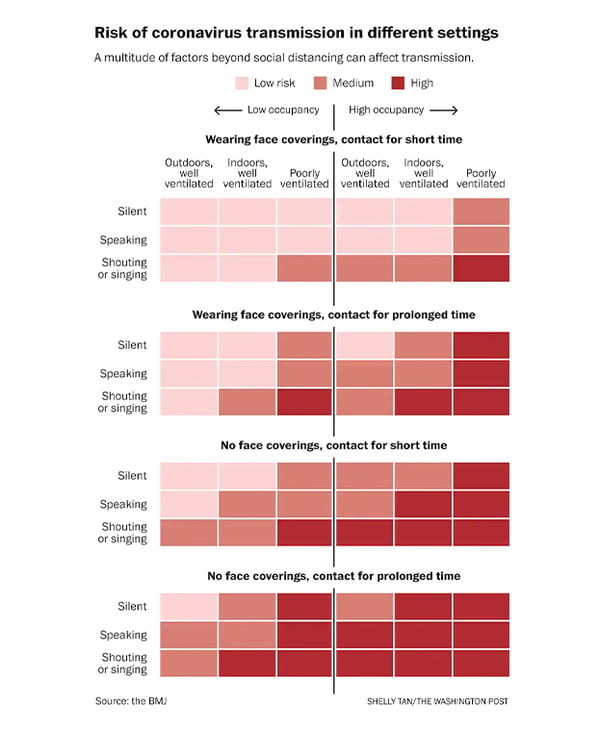
Image Source: Washington Post graphic representation of BMJ published study
[i] How Coronavirus Spreads through the Air: What We Know So Far
[ii] A prescription for better health: go alfresco
[iii] How Safe Are Outdoor Gatherings?
[iv] Want to buy schools time? Open the windows.
[v] SARS-CoV-2 Airborne Decay Calculator
[vi] The impact of green buildings on cognitive function
[vii] Exposure to Natural Light Improves Workplace Performance
[viii] Light and the circadian rhythm: The key to a good night's sleep?
[ix] Air Purifiers, Air Filters, and the Best DIY Hacks to Reduce the Coronavirus Risk
[x] ‘A Smoking Gun’: Infectious Coronavirus Retrieved From Hospital Air
[xi] COVID-19 Is Transmitted Through Aerosols. We Have Enough Evidence, Now It Is Time to Act
[xii] Installing air filters in classrooms has surprisingly large educational benefits
[xiii] Portable Air Cleaners: Selection and Application Considerations for COVID-19 Risk Reduction
[xiv] Shelly Miller Tweet 8/4/2020
[xv] Could a Janky, Jury-Rigged Air Purifier Help Fight Covid-19?
[xvi] A New Study Suggests a Possible Disease Vector: Germy Dust
[xvii] How the dust in your home may affect your health
[xviii] Ten questions concerning the implications of carpet on indoor chemistry and microbiology
[xix] How to use ventilation and air filtration to prevent the spread of coronavirus indoors
[xx] Indoor carbon dioxide levels could be a health hazard, scientists warn
[xxi] EPA: National Ambient Air Quality Standards
[xxii] CDC: How COVID-19 Spreads
[xxiii] Chemicals inhaled from spray cleaning and disinfection products and their respiratory effects. A comprehensive review
[xxiv] Hygiene Theater Is a Huge Waste of Time
[xxv] Antimicrobials: Are they harming us or helping us?
[xxvi] Design for the Environment Logo for Antimicrobial Pesticide Products
[xxvii] How air pollution affects your health - infographic
[xxviii] The Facts about Energy Recovery Ventilators

